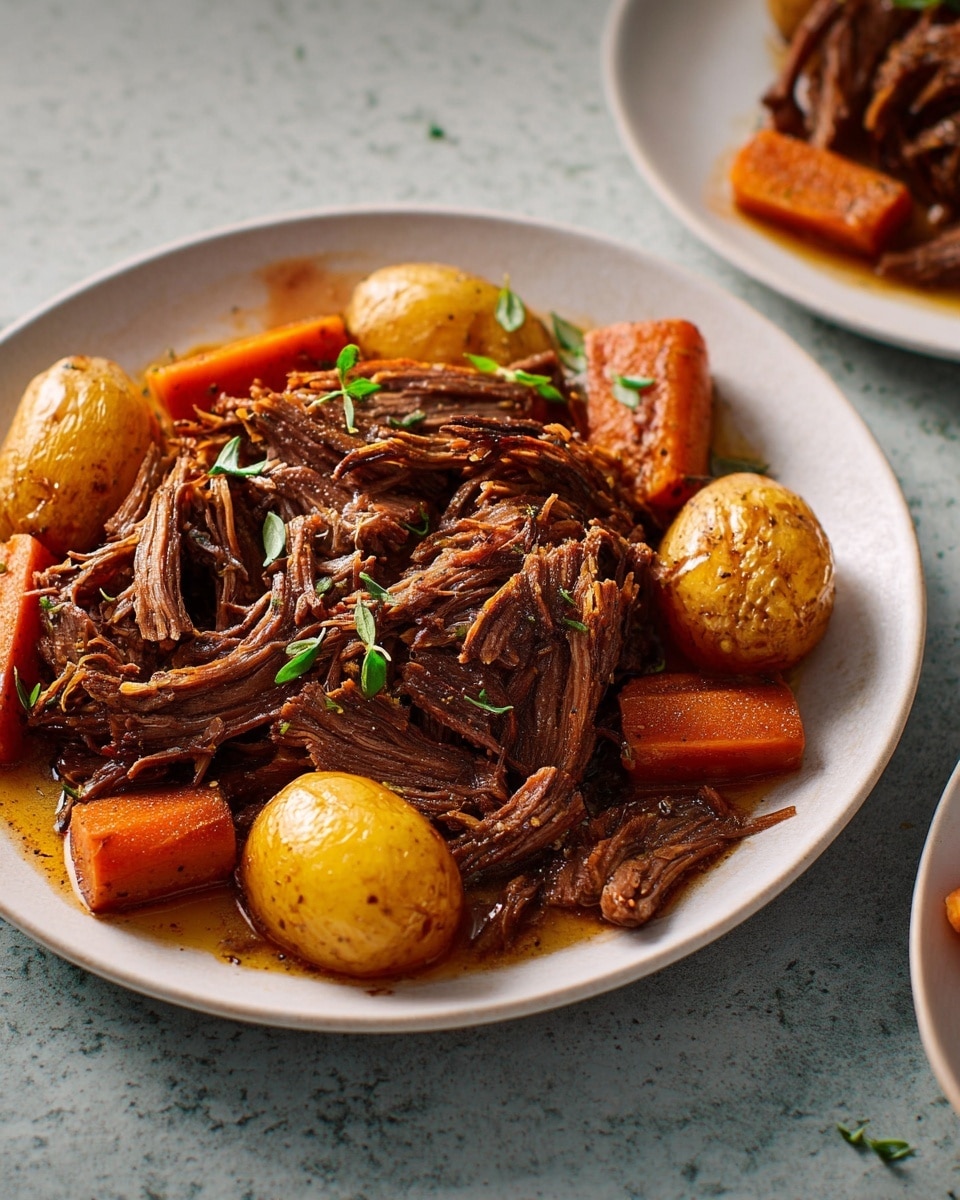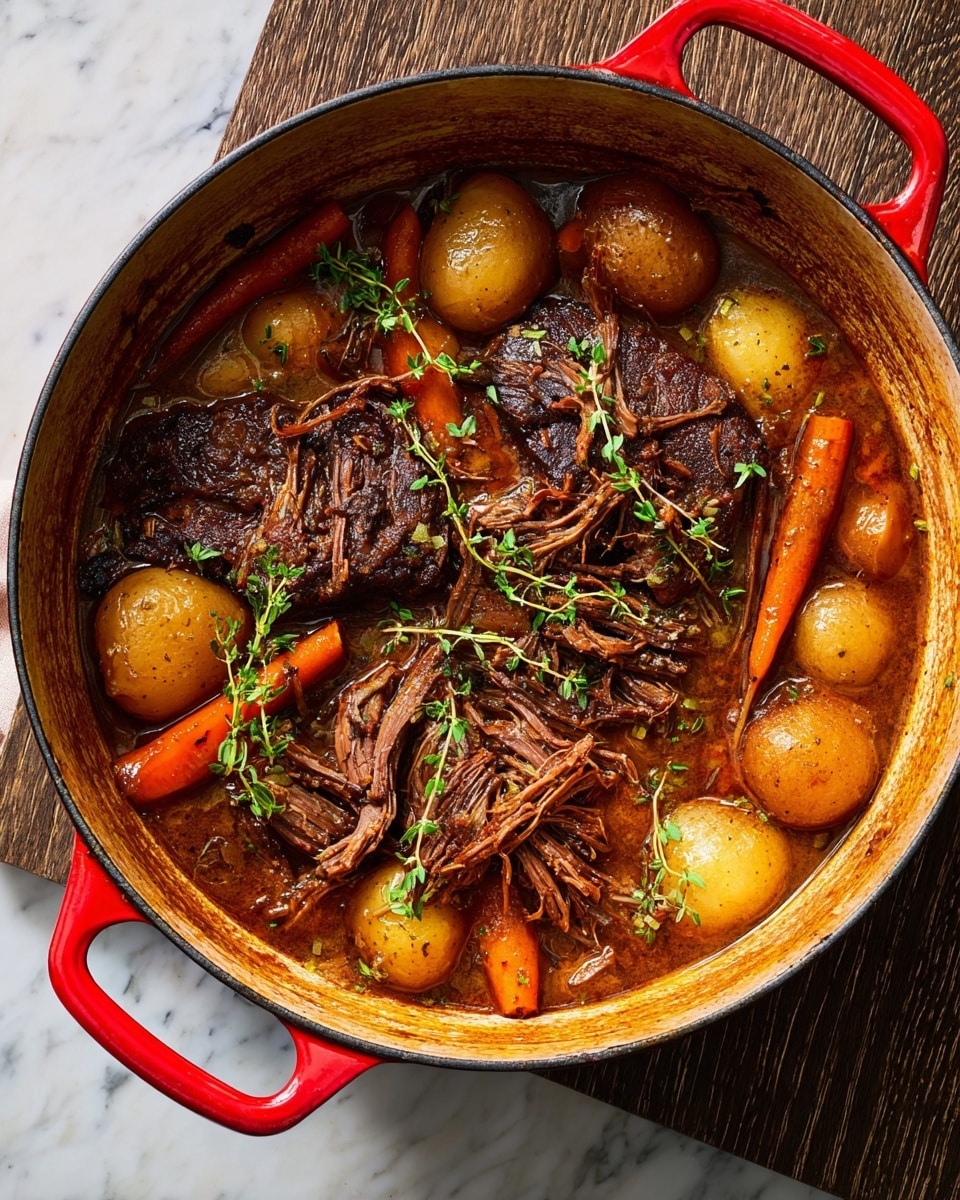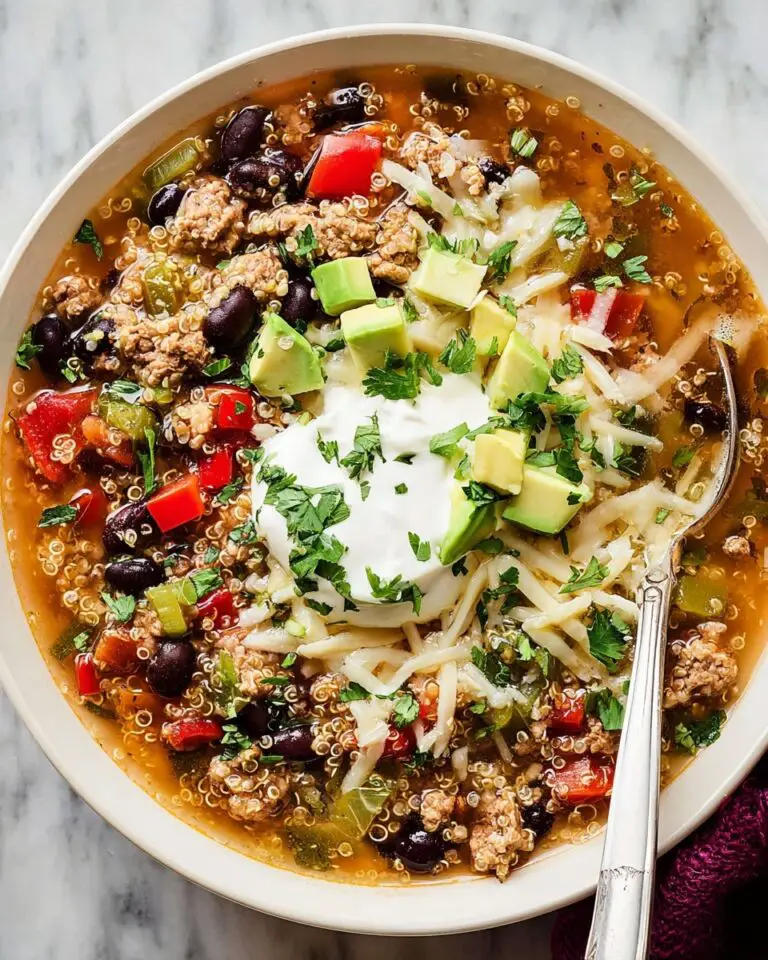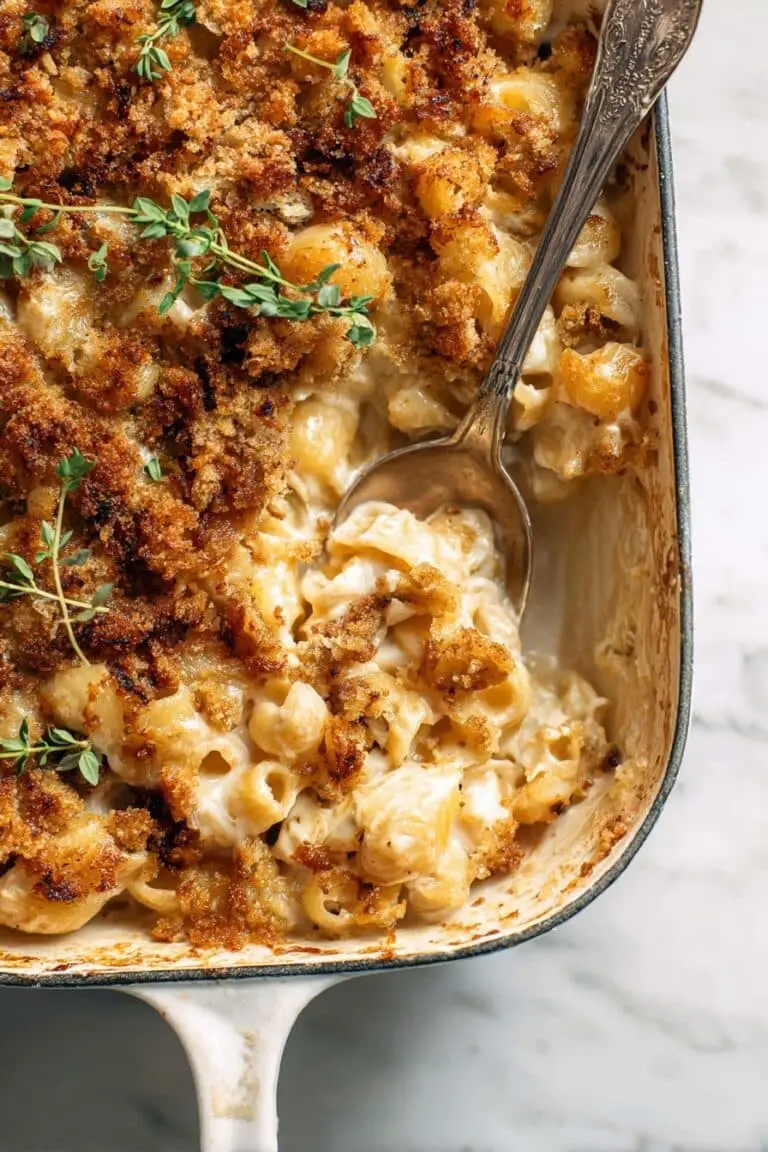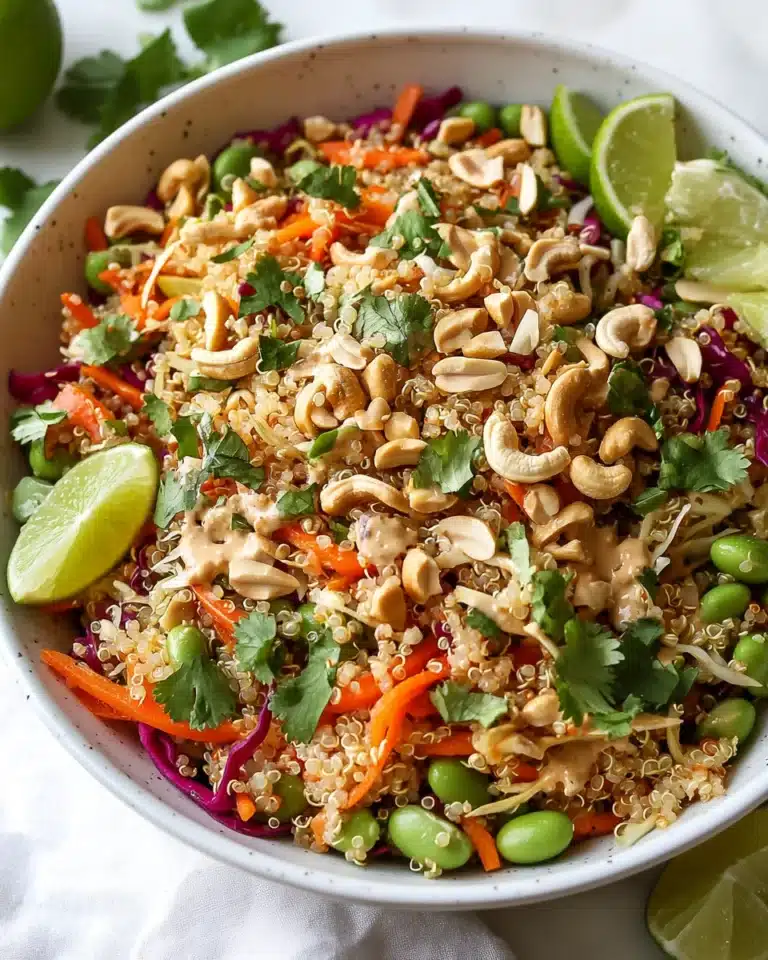I absolutely love how this Apple Cider Braised Brisket with Vegetables Recipe transforms a humble cut of meat into a tender, flavorful feast. The brisket slowly braises in a fragrant mix of apple cider and spices, soaking up all those cozy fall flavors that just warm you from the inside out. It’s the kind of dish you want to make when you have a bit of time to let things slow-cook, but trust me, the results are so worth the wait.
When I first tried this recipe, I was amazed at how the sweet apple cider balanced the rich, hearty brisket, and the vegetables cooked alongside add a vibrant touch of color and texture. You’ll find that this Apple Cider Braised Brisket with Vegetables Recipe is perfect for family dinners, special occasions, or any time you want to impress guests without stressing over complicated steps.
Why You’ll Love This Recipe
- Incredibly Tender Brisket: The slow braising in apple cider ensures the meat shreds easily and melts in your mouth.
- Balanced Sweet & Savory Flavors: Apple cider adds a natural sweetness that complements the earthy carrots and potatoes perfectly.
- One-Pot Comfort: Everything cooks together for easy cleanup and maximum flavor integration.
- Perfect for Any Occasion: Whether weeknight dinner or weekend gathering, this brisket impresses every time.
Ingredients You’ll Need
This Apple Cider Braised Brisket with Vegetables Recipe combines simple, easy-to-find ingredients that work beautifully as a team. Fresh herbs, apple cider, and a few spices turn the brisket into something truly special.
- Beef brisket: Look for a 3- to 4-pound cut with good marbling for delicious tenderness.
- Kosher salt: Essential for seasoning the meat and vegetables evenly.
- Freshly ground black pepper: Adds a subtle heat and depth of flavor.
- Neutral oil: Canola or vegetable oil works fine to sear the brisket without overpowering flavors.
- Baby potatoes: Halved so they cook evenly and absorb that braising liquid beautifully.
- Carrots: Peeled and cut into chunks, they bring sweetness and color to the dish.
- Shallots: Thinly sliced rounds add a mild onion flavor that softens in the braise.
- Apple cider: The star ingredient that imparts a gentle fruity sweetness and tenderizing acidity.
- Low-sodium broth: Beef or chicken broth to add richness without overwhelming saltiness.
- Thyme sprigs: Fresh herbs make a subtle aromatic difference in the braising liquid.
- Bay leaves: Provide a woodsy depth usually missing in simple stews.
- Cayenne pepper: Just a touch to add warmth and balance the sweetness.
Variations
I love playing with this recipe depending on the season or what’s in my kitchen. Feel free to swap veggies or adjust spices to suit your tastes — the brisket is super forgiving and adaptable.
- Vegetable swaps: I’ve used parsnips, sweet potatoes, or turnips instead of carrots and potatoes, and they soak up the flavors just as nicely.
- Spice it up: For a smoky twist, try adding smoked paprika or chipotle powder instead of cayenne.
- Gluten-free: This recipe is naturally gluten-free, just ensure your broth is labeled as such.
- Make it paleo: Use grass-fed beef brisket and ensure broth and apple cider are free from additives.
How to Make Apple Cider Braised Brisket with Vegetables Recipe
Step 1: Prep and Season the Brisket
Start by preheating your oven to 325°F. I always like to pat the brisket really dry with paper towels—that helps get a nice sear later. Season generously on all sides with kosher salt and freshly ground black pepper. Trust me, seasoning well at this stage makes all the difference in flavor depth.
Step 2: Brown the Brisket
Heat a large Dutch oven over medium-high and add the neutral oil. When it’s shimmering, place the brisket in and let it cook undisturbed for about 5 minutes per side, turning carefully to get all sides browned. Don’t rush this — that golden crust is flavor magic. Once browned, transfer the brisket to a large baking dish or plate.
Step 3: Sauté the Vegetables
Reduce the heat to medium and add the halved baby potatoes to the Dutch oven, cut side down. Let them sit undisturbed for about 5 minutes until they develop a bit of color and start to soften. Then toss in the carrots and shallots, seasoning everything lightly with salt and pepper. Stir gently to lift any browned bits from the bottom – that’s where loads of flavor hide!
Step 4: Add Liquids and Herbs
Return the brisket and any juices collected on the plate back into the pot with the vegetables. Pour in the apple cider and broth, then tuck in the thyme sprigs and bay leaves. Sprinkle the cayenne pepper and add extra salt and black pepper if needed. Stir everything gently to combine. Cover the pot and bring it all up to a boil on the stove.
Step 5: Braise in the Oven
Once boiling, pop the covered Dutch oven into the preheated oven. Let it slowly roast for about 2 ½ to 3 hours, until the brisket is so tender it practically falls apart at the touch of a fork. This slow cooking is where the magic happens – the flavors meld perfectly, and the meat becomes wonderfully juicy.
Step 6: Shred & Serve
Remove the thyme sprigs and bay leaves, then shred the brisket right in the pot using two forks. I like to toss the meat with the vegetables and their juices to soak up every bit of that braised goodness. Then, transfer everything to a serving platter and spoon more braising liquid over top for extra moisture and flavor.
Pro Tips for Making Apple Cider Braised Brisket with Vegetables Recipe
- Dry the Brisket Well: Patting the meat dry before searing ensures a better crust and seals in the juices.
- Don’t Skip the Browning Step: That golden sear adds deep flavor, so take your time and resist the urge to rush.
- Use Fresh Herbs: Fresh thyme and bay leaves make the braising liquid sing with aroma and complexity.
- Check Doneness with a Fork: The meat should shred easily—if it’s resistant, it needs more time, so be patient.
How to Serve Apple Cider Braised Brisket with Vegetables Recipe
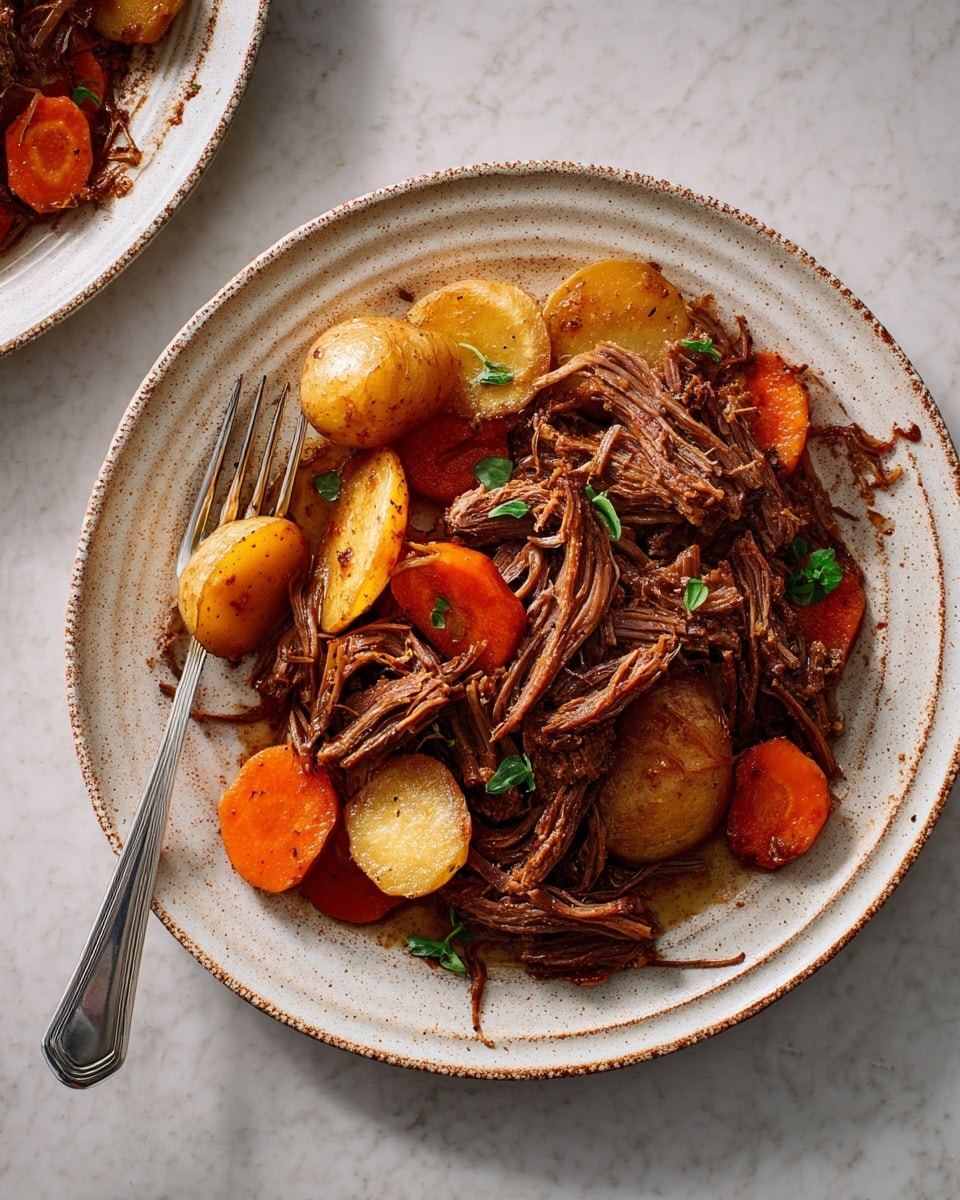
Garnishes
I like to sprinkle a handful of fresh chopped parsley or thyme over the dish just before serving—it adds a pop of color and freshness that balances the rich flavors. A little drizzle of good-quality olive oil or even a splash of apple cider vinegar can brighten things up too.
Side Dishes
This Apple Cider Braised Brisket with Vegetables Recipe pairs wonderfully with crusty bread to soak up the juices, a green salad for a fresh bite, or creamy mashed potatoes for extra comfort. Sometimes I serve it alongside sautéed greens like kale or spinach to add a nice contrast.
Creative Ways to Present
For special occasions, I’ve served this brisket on a large wooden board surrounded by roasted root vegetables, with little bowls of tangy mustard or horseradish on the side. It makes a stunning rustic centerpiece that invites everyone to dig in family-style.
Make Ahead and Storage
Storing Leftovers
I store leftovers in an airtight container in the fridge and usually find they taste even better the next day, as the flavors continue to meld. Just be sure to cool the brisket to room temperature before refrigerating to keep it fresh.
Freezing
This recipe freezes beautifully — I portion out the brisket and veggies with some of the braising juices into freezer-safe containers or bags. When you’re ready, thaw in the fridge overnight for the best texture.
Reheating
I recommend reheating the brisket gently on the stovetop over low heat, covered, to keep it moist. Adding a splash of broth or water if it’s looking dry works wonders. Avoid microwaving if possible, as it can dry the meat out quickly.
FAQs
-
Can I use something other than apple cider for braising?
Absolutely! While apple cider adds a unique sweetness and acidity, you can substitute with dry white wine, beer, or a mix of broth and apple juice if you don’t have cider on hand. Just keep in mind this will subtly change the flavor profile.
-
How do I know when the brisket is done?
The brisket is done when it’s fork-tender and shreds easily. This usually takes 2 ½ to 3 hours at 325°F, but ovens vary, so start checking around 2 hours and continue cooking until tender.
-
Can I make this recipe in a slow cooker?
Yes! You can brown the brisket and veggies on the stovetop first, then transfer everything to a slow cooker and cook on low for 6-8 hours until tender. Just add the apple cider, broth, and herbs as directed.
-
What can I serve with leftovers?
Leftover brisket makes fantastic sandwiches, tacos, or hash when diced and pan-fried with potatoes and onions. It’s a versatile base for quick meals following the initial feast.
Final Thoughts
This Apple Cider Braised Brisket with Vegetables Recipe has become one of my go-to comfort meals, especially in the cooler months when you crave something hearty yet bright with flavor. It’s simple enough to make any weekend but special enough to impress guests effortlessly. I hope you enjoy making and eating it as much as my family does — it truly feels like a warm hug on a plate!
Print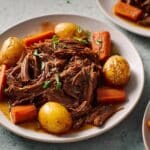
Apple Cider Braised Brisket with Vegetables Recipe
- Prep Time: 15 mins
- Cook Time: 3 hrs
- Total Time: 3 hrs 15 mins
- Yield: 8 – 10 servings
- Category: Main Course
- Method: Baking
- Cuisine: American
Description
This Apple Cider Braised Brisket is a comforting and flavorful dish where tender beef brisket is slow-roasted in a rich apple cider and broth mixture with baby potatoes, carrots, and aromatics. The brisket becomes perfectly shreddable after hours of gentle roasting in the oven, absorbing the sweet and savory notes from the cider and spices, making it an ideal centerpiece for a hearty family meal.
Ingredients
Beef Brisket
- 1 (3- to 4-lb.) beef brisket
- Kosher salt, to taste
- Freshly ground black pepper, to taste
- 2 Tbsp. neutral oil
Vegetables
- 1 1/2 lb. baby potatoes, halved
- 4 large carrots, peeled and cut into 2″ pieces
- 2 shallots, sliced into 1/4″-thick rounds
Liquids & Seasonings
- 4 cups apple cider
- 1 1/2 cups low-sodium beef or chicken broth
- 6 sprigs thyme
- 2 bay leaves
- 3/4 tsp. cayenne pepper
- Kosher salt and freshly ground black pepper, additional for seasoning
Instructions
- Preheat and Season: Preheat your oven to 325°F (163°C). Pat the brisket dry using paper towels, then season it generously on all sides with kosher salt and freshly ground black pepper to enhance flavor.
- Brown the Brisket: Heat the neutral oil in a large Dutch oven over medium-high heat. Add the brisket and brown it, turning occasionally to ensure all sides develop a deep, flavorful crust. This should take about 5 minutes per side. Once browned, transfer the brisket to a large baking dish temporarily.
- Sauté Vegetables and Deglaze: Reduce the heat to medium. In the same Dutch oven, place the halved baby potatoes cut side down and cook undisturbed until they start to soften and develop a slight crust, about 5 minutes. Add the carrots and sliced shallots and season with salt and pepper. Stir gently to release any browned bits stuck to the pot.
- Add Brisket and Liquids: Return the brisket along with any juices accumulated on the baking dish back into the Dutch oven. Pour in the apple cider and low-sodium broth, then add the thyme sprigs, bay leaves, and cayenne pepper. Season again with salt and pepper and stir to combine all the ingredients thoroughly. Cover the pot and bring the mixture to a boil on the stovetop.
- Roast in Oven: Once boiling, transfer the covered Dutch oven to the preheated oven. Roast the brisket until it is very tender and easily shredded with a fork, about 2 1/2 to 3 hours.
- Finish and Serve: Remove the pot from the oven. Discard the thyme sprigs and bay leaves. Use two forks to shred the brisket into bite-sized pieces. Transfer the shredded brisket to a platter, arrange the roasted vegetables alongside, and spoon the cooking juices over everything to serve.
Notes
- You can substitute low-sodium chicken broth with beef broth according to preference.
- If you prefer a thicker sauce, after removing the brisket, simmer the cooking liquid on the stovetop uncovered to reduce it.
- For extra smoky flavor, sprinkle smoked paprika along with the cayenne pepper.
- Leftover brisket is excellent for sandwiches or tacos the next day.
Nutrition
- Serving Size: 1 slice with vegetables (approx. 6 oz brisket with vegetables)
- Calories: 420 kcal
- Sugar: 9 g
- Sodium: 310 mg
- Fat: 20 g
- Saturated Fat: 7 g
- Unsaturated Fat: 11 g
- Trans Fat: 0.1 g
- Carbohydrates: 18 g
- Fiber: 3 g
- Protein: 38 g
- Cholesterol: 110 mg

